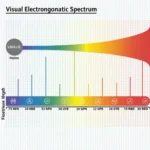Have you ever looked up at the night sky and seen a comet streaking across the darkness? It’s a breathtaking sight, leaving a trail of wonder in its wake. But have you ever stopped to wonder, “What is the color of a comet?” It’s not as simple as a single hue. A comet’s color is a fascinating interplay of its composition, the sun’s light, and our perception.
Deciphering the Cosmic Palette
While we often picture comets as blazing white streaks, their true colors are much more nuanced. A comet’s appearance is determined by several factors, primarily the materials that make up its nucleus and the way sunlight interacts with these elements.
A Closer Look at Comet Composition
Comets, often dubbed “dirty snowballs,” are cosmic conglomerates of ice, dust, and rock. This frozen mixture forms the comet’s nucleus, which is typically only a few kilometers wide. When a comet ventures closer to the sun, the increasing heat begins to vaporize the ice and other volatile materials within the nucleus. This process forms a hazy cloud around the comet called the “coma,” and it’s within this coma that the comet’s color story unfolds.
Sunlight: The Cosmic Artist
Sunlight plays a pivotal role in revealing the hidden colors of a comet. As sunlight reaches the coma, it interacts with the released gases and dust particles. Some wavelengths of light are absorbed by these particles, while others are scattered, creating the colors we see from Earth.
 Comet Composition
Comet Composition
The Spectrum of Comet Colors
So, what colors can comets exhibit? Here’s a glimpse into the cometary palette:
- White: The most common color we perceive, often due to the scattering of sunlight by the dust particles in the coma.
- Blue: This ethereal hue often manifests in the comet’s ion tail, formed when solar wind ionizes the released gases.
- Green: Certain molecules, like diatomic carbon (C2), emit green light when excited by sunlight, giving the coma a greenish glow.
 Comet Tail Colors
Comet Tail Colors
Factors Influencing Our Perception
It’s important to note that our perception of a comet’s color can be influenced by various factors:
- Distance from the Sun: A comet’s color can change as it journeys closer to or farther from the sun. The intensity of solar radiation affects the rate of vaporization and the types of molecules released, ultimately impacting the observed color.
- Earth’s Atmosphere: Our atmosphere can scatter and filter light, potentially altering the colors we perceive from Earth.
- Telescopes and Imaging: Different telescopes and imaging techniques can reveal a broader spectrum of colors and details that might not be visible to the naked eye.
A Symphony of Science and Beauty
The color of a comet is not merely a visual spectacle; it’s a window into the comet’s composition and the complex interplay of light and matter in our universe. As these celestial wanderers grace our skies, they remind us of the vast beauty and scientific wonders that lie beyond our world.

